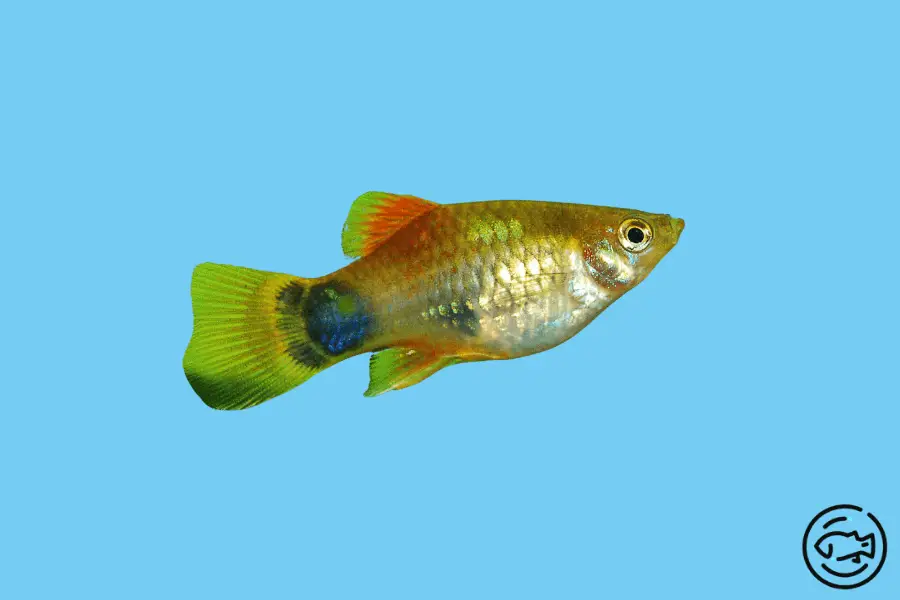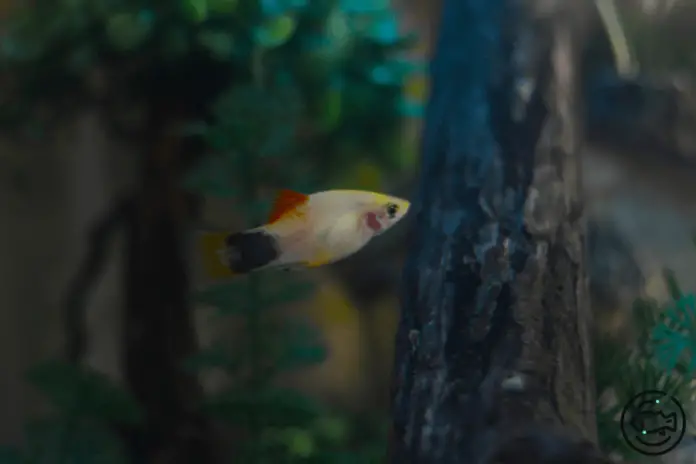The Mickey Mouse Platy is a freshwater fish popular in the aquarium trade. The fish is named for its large, round fins and tail that resemble the ears and head of Mickey Mouse.
The Mickey Mouse Platy was originally a common species of fish that lived in the waters of Central Asia. However, in the 1960s, human activity caused its numbers to decline, becoming classified as endangered.
This decline has been attributed to habitat loss, overfishing, and pollution. Thus, to preserve the species, an attempt in 2001 to reclassify this species from endangered to vulnerable by the IUCN.
Description

Mickey Mouse Platies are small fish with a length of only 3 inches (7.6 cm). They are deep-bodied, round, and fat with large rounded fins and a large tail whose shape looks like Mickey’s ears and face.
The dorsal fin is adipose (i.e., made of fat) and round. The caudal fin is even more rounded and has white leading edges.
Body coloration is green or mottled, with a pattern resembling Molly’s body pattern, and the fins are orange to red, depending on their body color tone.
They are hardy fish that adapt readily to aquarium life and make good tank mates for many fish species.
Origin and Distribution
Mickey Mouse Platies were transported to the United States from Thailand in 1967 for use as live bait for fishing (specifically, for bait in ice fishing).
This is ironic because these Mickey Mouse Platies are now very popular aquarium fish, especially among hobbyists in the U.S.
The species was first imported into the U.S. in 1969 and established in the aquarium trade in 1972.
The Mickey Mouse Platy is common in hobbyist tanks across the United States and Canada. They are often displayed on their own or with other small fish species, such as rainbow fish, zebra danios, guppies, and tetras.
Habitat & Lifespan
They are native to the rivers of central Asia, where they live in slow-moving water with cooler temperatures than those found in temperate regions.
The Mickey Mouse Platy is a bottom dweller that eats insects and microorganisms, both larvae and adults.
The Mickey Mouse Platy is adaptable to various water conditions, such as different temperatures and pH levels. These fish are also very hardy and live in the aquarium for a fairly long time (4-7 years).
In the wild, the Platy lives in small groups of up to six fish that may migrate from one flooded area to another.
This species tends not to feed in schools because of competition for food. However, this is not true in captive breeding facilities, where they are often maintained with other species that usually don’t eat as much.
Thus they will often stay close together when spawning so that all can benefit from being able to eat more during spawning season.
Mickey Mouse Platies have been known to spawn in the wild, and captive breeding started in the early 1970s.
As a result, the species has become widely established as a staple of the aquarium hobby, even though it is not native to the United States.
There are two distinct populations of Xiphophorus variatus that their fin coloration can distinguish: one has red fins with some white, while the other has orange fins with some red. The latter is bred more frequently and hatches readily in aquariums.
Commercial Species/Strains/Markets/Products
There is little known about any specific commercial uses for this species other than live bait for fishing (i.e., as live fish used by anglers).
However, this species is commonly found in the aquarium trade, where it is sold under various common names, such as Xiphophorus and Asian Platy/Mickey Mouse Platy.
Breeding

Mickey Mouse Platies are now bred successfully in many areas of the world, including cold water hatcheries in Central Asia. However, they are now bred commercially in the U.S., Canada, the Netherlands, Singapore, and Japan.
The spawn is released into a tank of water with live plants over which a glass dome encloses to give it a more natural look.
The eggs are transparent, with a dark spot on each side near one end. The eggs are covered in a film of mucus.
After the eggs hatch, the fry emerges from the adhesive egg case. The fry is transparent and later develops fins.
A reproduction will begin within a few days in an aquarium with temperatures that range from 77-96°F (25-36°C).
Fry can be fed infusoria, brine shrimp nauplii, or micro worms to promote early growth rates and prevent cannibalism by larger fish. Once the fry is about 3 mm long, they can be switched to flake food until they reach 1cm in length.
Producers suggest keeping the temperature between 77-86°F (25-30°C), pH 6.5-7.4, and dosing 2-4 drops of Vitamin C for every 10 gallons of aquarium water.
In the wild, the Mickey Mouse Platy is nocturnal, but in the aquarium, it is often kept on its own if it is housed with other fish or if it is housed with its kind.
They should be fed a varied diet that contains high-protein foods to ensure proper growth and development.
The fry will accept most foods, including sinking pellets and flake food. As they mature, the fry will take frozen and live brine shrimp, micro worms, mosquito larvae, and adult brine shrimp for food.
This species is believed to eat various small insects, other aquatic invertebrates, and zooplankton in the wild.
In aquariums, natural foods are fine for this species as long as it gets enough protein to grow enough muscle to get along with other large fish in the tank (see fish compatibility).
Although the Mickey Mouse Platy is very hardy, it is best to keep it in an aquarium without other fish (although it may be kept with other species of smaller fish) because of its fighting ability.
These fish are aggressive and may injure or kill other aquarium fish. In addition, this species possesses sharp teeth that may penetrate the flesh of other fish in a tank.
Some specimens will even attack their kind if they have to share an aquarium with others of their kind. Therefore, this species is not recommended for the first time aquarist.
Feeding
Mickey Mouse Platies are carnivorous and eat small insects and other small, fast-moving organisms that they can catch in the aquarium water.
They will also nip at things that they see moving too quickly or against which they are bumping their bodies.
For these reasons, little care must be taken when feeding this species to ensure it gets enough food.
Instead, the best thing to do is place the food in sites where the fish can easily reach it without fighting with another fish or escaping into an area of live plants.
Tank Requirements
Mickey Mouse Platy is a poor competitor and has very low survival rates in the wild. The species seems to have very specific habitat requirements.
It occurs in warm shallow water with a lot of vegetation, such as lilies and leaves. This species may stay in one area for weeks or months before moving to another flooded area where it can find food and clear water during cold weather.
These fish generally stay close together when not feeding and will move from one flooded area to another unless the water is too deep for their comfort range of six inches or less (15 cm).
Mickey Mouse Platies are often found in ponds or the backwaters of creek systems. They prefer to stay where loose soil, leaf litter, and other debris can be moved when the water level rises.
In addition, they prefer to stay within areas with a good supply of plant material available for use as cover.
This species will generally do well in a heavily planted tank with subdued lighting and plenty of surface floating plants to provide cover in captivity.
Floating plants should be anchored at each end so that the softer parts (such as leaves) will be in water that does not move too much.
The Mickey Mouse Platy’s preferred temperature range is between 77-86°F (25-30°C).
Therefore, these fish will stay close together, hide in aquatic plants during the day, and then feed at night. In this way, they are like a cat that sleeps all day and then hunts at night.
Mickey Mouse Platies are hardy fish that do not require much attention but need to be fed often because of their high metabolism.
Tank Mates
These small fish will bite the fins of other fish, so keeping them with other species of smaller fish is best.
This species should not be kept with larger or more aggressive (not just larger) species of aquarium fish due to its potential for injuring or killing others in an aquarium by biting them on their fins, tails, or body.
Mickey Mouse Platies are usually aggressive towards conspecifics of the same species and not towards fish of other species.
They can be kept with small cyprinids, catfishes, and characins as long as they do not bully them.
The Mickey Mouse Platy is easy to spawn if the water conditions are right. The fish will lay eggs in an area with many floating plants and then guard them until they hatch.
The male will guard the eggs (and fry) while the female looks for food. Once hatched, they can start eating very small foods such as brine shrimp larvae, micro worms, and infusoria.
The Mickey Mouse Platy is a good choice for those who have had trouble spawning other species of fish in past aquariums because it does well in captivity when kept with other small fishes similar to their natural food sources in size and habit.
The Mickey Mouse Platy can be fed with frozen foods such as plankton diets, Spirulina algae by Cobalt, and various shrimps and worms.
Frozen foods are good at helping this species attain the feeding levels needed to keep it healthy while in captivity so that they do not need to be fed too often. In addition, they can feed on live foods such as mosquito larvae, daphnia, and brine shrimp.
Conclusion
Mickey Mouse Platy is one of the most popular livebearers to be kept by aquarists in captivity.
It can be a fascinating fish because it has many different color patterns depending on the sex.
It is also hardy, easy to breed, and popular for use in hybridization experiments with other species of captive-bred livebearers.



